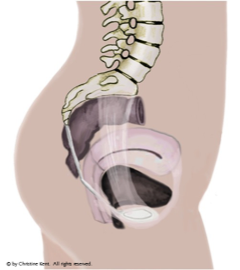Essential Reading for the Whole Woman
Cystocele (Bladder Prolapse)
The most common form of pelvic organ prolapse is cystocele or bladder prolapse.
The breakthrough I made in my research on prolapse is that technically, it really isn’t a gynecologic problem at all. If we have to give prolapse a medical name, it actually is more of an orthopedic problem because the pelvic organ support system is a full-body, postural system.
 Unlike virtually every anatomy book portrays, your pelvis is not positioned like a bowl with the opening at the bottom. It is really positioned like a ring on its edge with the opening at the back. Any woman can easily verify this for herself. Your pubic bones are underneath you like straps of a saddle.
Unlike virtually every anatomy book portrays, your pelvis is not positioned like a bowl with the opening at the bottom. It is really positioned like a ring on its edge with the opening at the back. Any woman can easily verify this for herself. Your pubic bones are underneath you like straps of a saddle.
What this means is that the so-called “pelvic floor” isn’t really a floor at all. It is actually one of our body walls.
When the bladder and urethra are well supported, they are positioned over the horizontal pubic bones. We have a strong, bony pelvic floor underneath the body, and a muscular wall at the back. The bladder is actually supported by your lower belly, not a soft-tissue "pelvic floor."
The pelvic organs are kept in their correct positions by breathing naturally under the forces of gravity, the natural shape of the spine, and the weight of the organs themselves.
The lower back or lumbar curvature is genetically more pronounced in females for just this reason. If you spent your days sitting cross legged on the ground, or with your legs stretched out in front, or walking with heavy loads balanced on your head, you too would have a pronounced lumbar curvature.
However, you probably don’t. You have a comfy sofa and chairs at home, and cushy seat in your car. All of these modern conveniences lead to weakened back muscles and loss of lumbar curvature. In turn, the pelvic organs lose their anatomical positions against the lower abdominal wall to prolapse out the back.
Fortunately, if you have been able to avoid pelvic surgery, such as hysterectomy and other “repairs”, you have every likelihood of restoring your proper organ placement by developing natural female posture.
If you have cystocele, it is likely you also have some level of rectocele, which we at Whole Woman often refer to as “nature’s pessary” because the rectum bulging in from the back, and the bladder bulging in from the front prevent the uterus from prolapsing to the vaginal opening.
The Pessary - Short Term Help

Your doctor may have suggested a pessary, which is a silicone rubber device inserted into the vagina, rather like a diaphragm. As you can see in the picture from the Cooper Surgical catalogue, they come in a variety of shapes - all designed by doctors.
The pessary’s purpose is to push the bladder toward its normal position, thus minimizing bulging into the vagina. As a temporary expedient it can be useful, but a pessary is not a long-term solution. Each type of pessary comes in a variety of sizes and it may take several fittings to find one that is comfortable and stays in place.
Cooper Surgical, who is the major manufacturer of Milex pessaries in the United States, includes a tube of Trimo San vaginal lubricant with each pessary. You should be aware that the active ingredient in Trimo San, hydroxyquinoline sulfate, is unapproved by the USDA for use on cattle, but is considered by the FDA to be fine for women to put in their vaginas. Mouse models have shown a connection between hydroxyquinoline sulfate and lymphoma.
Managing prolapse means learning about your anatomy, restoring your natural female posture, strengthening the musculature (which has nothing to do with kegels) that has gotten lazy, and being mindful of your posture while sitting, standing, walking, running, lifting and carrying.
Christine Kent
Founder
Whole Woman

